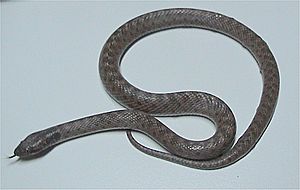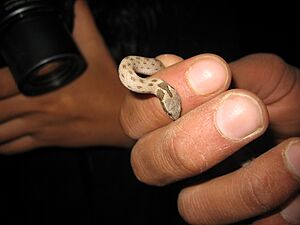Night snake facts for kids
Quick facts for kids Night snake |
|
|---|---|
 |
|
| Texas night snake (Hypsiglena torquata jani) | |
| Scientific classification | |
| Genus: |
Hypsiglena
|
| Species: |
torquata
|
 |
|
| Synonyms | |
|
|
The night snake (Hypsiglena torquata) is a small, shy species of rear-fanged colubrid snake. It gets its name because it is mostly active at night. You can find this snake in the southwestern and western United States, as well as in Mexico and British Columbia, Canada.
Contents
What Does a Night Snake Look Like?
Night snakes are usually about 12 to 26 inches (30 to 66 centimeters) long. They can be pale gray, light brown, or beige. They have dark gray or brown blotches, which are like spots, on their back and sides.
Head Features
The night snake's head is quite flat and shaped like a triangle. It usually has two dark brown blotches on its neck. There is also a black or dark brown bar right behind its eyes. This bar stands out against the white or pale gray scales on its upper lip. One of the most interesting features is its eye: the pupil is vertical, like a cat's eye. The snake's belly is white or yellowish. Female night snakes are usually a bit longer and heavier than males.
Where Do Night Snakes Live?
Night snakes live in a wide area, from southern British Columbia in Canada all the way down to Guerrero, Mexico. Their range also stretches east into Texas. It can be hard to know exactly how many night snakes there are or their exact range. This is because they are very good at hiding and are not often seen.
Night Snake Habitats
These snakes can live in many different kinds of places. You might find them in grasslands, deserts, sagebrush flats, and chaparral areas. They also live in woodlands, thorn forests, and mountain meadows. Night snakes are comfortable in both rocky and sandy areas. They have even been found at high elevations, over 8,500 feet (2,590 meters) above sea level. They sometimes even live inside mammal burrows.
Night Snake Behavior
Night snakes are mostly active during the evening and night. This means they are crepuscular (most active at dawn and dusk) and nocturnal (active at night). People often see them crossing roads after dark. During the day, they hide under rocks, pieces of wood, dead branches, or other things on the ground.
Seasonal Activities
Night snakes hibernate during the cold winter months. This is like a deep sleep to save energy. They are also known to aestivate during very hot periods in the summer. This is similar to hibernation but happens in warm weather. They are usually most active from April to October, with their busiest time often in June.
Venom and Diet
The night snake is slightly venomous. This means it has a mild venom. However, it is not dangerous to humans. They use their venom to help them catch and calm down their prey.
What Do Night Snakes Eat?
Night snakes mainly eat lizards. A study in Idaho found that they mostly eat side-blotched lizards and their eggs. They also eat other small animals like young rattlesnakes, blind snakes, salamanders, frogs, and large insects.
Defense Mechanisms
If a night snake feels threatened, it has a few ways to protect itself. It might coil its body up and then quickly thrust its coils towards whatever is bothering it. It can also flatten its head, making it look more triangular and scary to a possible threat.
Night Snake Reproduction
Night snakes usually mate in the spring. After mating, female night snakes lay a clutch of 2 to 9 eggs. They lay their eggs between April and August. The eggs hatch about 7 to 8 weeks later, usually in the late summer. Male night snakes become old enough to reproduce when they are about one year old.
Night Snakes and People
Night snakes are known to be calm and easy to handle if they are kept as pets. In captivity, some night snakes have lived for over 12 years!
Species Hypsiglena torquata at The Reptile Database


